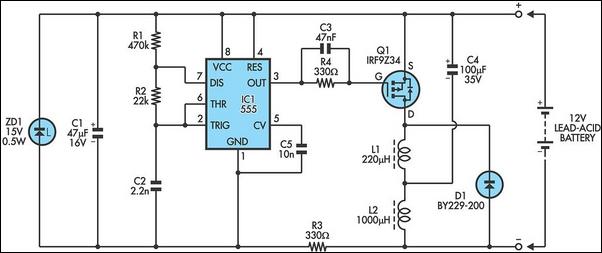Home » Circuits
12V Lead Acid Battery Desulphator
Lead acid batteries often fail prematurely due to over-charging, under-charging, deep discharging and low electrolyte level. All of these can lead to sulphation of the plates which leads to high internal resistance and eventual failure. Normally, this process is regarded as irreversible but this circuit is claimed to reverse the process by applying high voltage pulses to break down the lead sulphate compounds. The circuit is essentially a high-voltage pulse generator which is powered directly from the battery in question. If the battery is badly sulphated, it will be necessary to connect it to a low power charger as well, say 2A. We have strong doubts about whether battery sulphation can be effectively reversed but we are publishing this circuit because the subject is of particular interest.Circuit diagram:
This circuit has been submitted to us from a number of sources so we do not know who is the original designer. More information can be found at http://shaka.com/~kalepa/desulf. The 555 timer is connected as an astable oscillator with its output frequency set by R1, R2 and C2. Its output pulses drive the gate of Mosfet Q1 which turns on to charge inductors L1 and L2. At the end of each pulse, Q1 turns off and the inductors develop a high-voltage high-current pulse which is applied across the battery via fast recovery diode D1 and the 100µF capacitor. The 555 is protected from the high voltage pulses via its isolated supply, by virtue of the 15V zener diode ZD1, the 47µF capacitor and the 330Oresistor R3.
Author: Silicon Chip - Copyright: Silicon Chip Electronics Magazine

